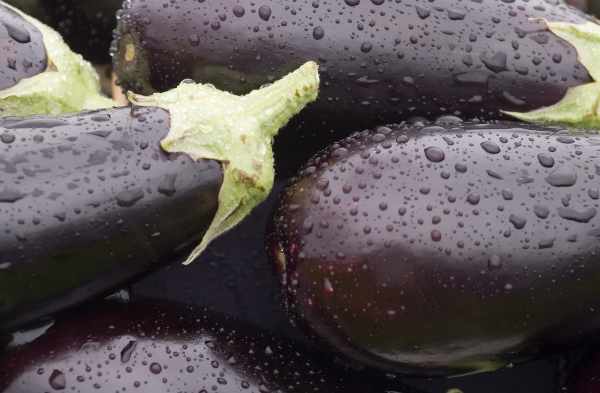An introduction to Aubergine
Very low calories, loaded with beneficial nutrients, with a distinctive taste and sponge-like texture, she was once believed to be poisonous and actually contains more nicotine than any other vegetable (don’t worry though; you’d need to consume 30lbs of aubergine to ingest the amount of nicotine you’d get from smoking a cigarette). Aubergine is not the only vegetable that contains traces of nicotine however; tomatoes, potatoes, cauliflowers and green peppers also contain very small amounts.

When you think of aubergines you naturally think of them in a vegetable patch, but did you know that an aubergine isn’t actually a vegetable; it’s technically a fruit – a berry to be exact! Part of the nightshade family (which also includes tomatoes, sweet peppers and potatoes) the aubergine originates from India, where she is considered the queen of the vegetable patch. The majority of aubergines today however are produced in China and also cultivated in other temperate climates including India, Iran and Egypt. A versatile addition to your diet; they feature in many popular dishes and can be fried, stewed, stir-fried, baked, stuffed, roasted, curried, pickled or pureed and incorporated into a host of delicious recipes.
Varieties of aubergine

Although the most widely known and used variety of aubergine, the Italian aubergine, is a signature dark purple you can also find white, black, green and red types.
The size and shape also differs greatly across different varieties. Italian aubergines are the most widely used and feature in some of the world’s most popular dishes including ratatouille, moussaka, parmigiana, pizzas and pastas. In contrast the unusual ‘Toga’ variety is orange with green stripes and is strong in flavour. Chinese aubergines are long, thin and dark lavender in colour and are great in stir fries and pickles. The Filipino aubergine is long, thin and dark green in colour with specks of light purple and works best when roasted or mashed.
Indian aubergines are dark red and small (about the size of an egg) and are usually cooked in curries, soups and stews, whilst Japanese aubergines have a sweeter taste and are short and thin with dark purple skin and dark-coloured stems; they are often pickled or used in tempura. The Thai aubergine is great for curries; green and round in appearance and much smaller than the other varieties.
Nutritional information
Aubergines are a good source of dietary fibre, calcium, antioxidants and vitamins including vitamin C, vitamin K, vitamin B6, thiamin and niacin. They are virtually fat free and low in calories, sodium and cholesterol and high in folic acid. Aubergines also come loaded with a host of minerals essential for the effective functioning of the body, including magnesium, phosphorus, copper, and potassium.
![]()
Health benefits

Aubergine skin is the most prominent natural source of nasunin; a potent antioxidant which prevents iron accumulation and neutralizes free-radicals, giving it anti-ageing properties. So don’t discard it! Nasunin also protects lipids (fats) in brain cell membranes and has cancer-fighting properties since it restricts the growth of new blood vessels, whilst keeping present blood vessels clear and relaxed.
The flavonoids found in aubergines play an important part in heart health, whilst the presence of phenolic compounds can actively reduce blood pressure, lower cholesterol and help to prevent the formation of blood clots. Regular consumption of aubergine is recommended as a natural way to manage type 2 diabetes, as it can help to control glucose absorption and reduce associated high blood pressure, as well as being a high-fibre, low fat food.
Juice made from the leaves and roots of the aubergine can be effective in treating throat and stomach disorders, asthma, toothache, rheumatism and skin problems.
Aubergine recipes
Aubergine & Lentil Soup
Aubergine Lasagne
Courgette & Aubergine with Chickpea Puree
Potato, Aubergine & Mushroom Curry





 Looking for our products in a store near you?
Looking for our products in a store near you?
